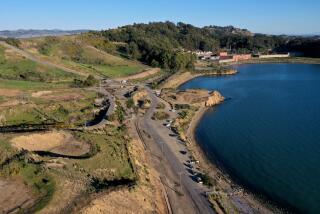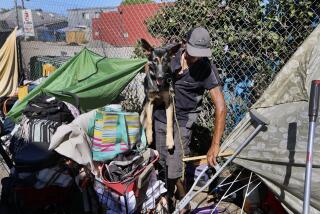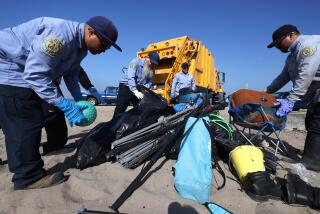In Ballona Wetlands preserve, homeless are unwanted intruders
As land manager of the Ballona Wetlands just south of Marina del Rey, ecologist Richard Brody thinks he has a “dream” job — but one that comes with an unusual caveat.
Along with being able to name nearly every type of flower, tree and animal dotting the 600-acre state preserve, he must fight a seemingly endless stream of homeless people who try to take root there.
Brody was hired in October 2013 to manage the preserve and address the growing number of encampments and the problems they have created. Parts of the wetlands have been littered with syringes and liquor bottles that can endanger wildlife. And the underbrush can serve as a hiding place for suspected vandals and thieves, such as those who periodically plague the nearby Culver-Marina Little League field.
Culver-Marina Little League Vice President Matthew Wind recalls arriving at the field one day in August to find that nearly everything that wasn’t bolted down had been stolen, including a heavy pitching machine and several banners and trophies. The walls of the snack bar and equipment room were covered with profane, satanic graffiti.
A few days later, the league received a water bill for $3,000. The pipes servicing the fields had been smashed, causing a huge leak. The field now remains dry and barren as the league looks for a way to pay for damage estimated at close to $50,000.
“We have minor vandalism incidents in the offseason nearly every year,” Wind said. “But this is the worst it’s ever been.”
The Ballona Wetlands are closed to the public unless accompanied by Brody, 51, or an approved volunteer, but it’s easy to gain entry illegally through holes in the chain-link fences that surround its 11-mile perimeter. Only a few areas are actually low-lying, marshy wetlands. The rest — including the land leased by the Little League — is upland and full of tall vegetation, creating shaded pockets of land where encampments often pop up.
The vandalism was easily traced to the encampments, Brody said, because thieves had dragged stolen equipment across the sandy field, leaving tracks that took LAPD officers directly to encampments surrounding the baseball field. After finding much of the stolen equipment, two arrests were made.
However, Wind believes the arrests are only a temporary solution.
“Until these camps are out for good, [the arrests] are like putting lipstick on a pig,” he said.
Concerted efforts to address the homeless issue began last year after a member of the Friends of Ballona Wetlands, a nonprofit group dedicated to restoration of the wetlands, happened upon a debris-filled encampment off a bike trail that runs past Ballona Creek. Some of those living in the camp were also siphoning electricity from nearby power boxes, said Lisa Fimiani, executive director of the Friends of Ballona Wetlands.
In the following months, crews from the state and the city of Los Angeles conducted several cleanups, at one point removing 300 bags of trash from a particularly entrenched encampment.
But law enforcement agencies can’t do it all, Fimiani said: “If it’s between breaking up a homeless camp in the wetlands and dealing with a homicide, the priority is the homicide. We need someone — the City Council, the state — to provide more funding for patrols and outreach.”
Removing an encampment is laborious — first, Brody enters with a member of the Sheriff’s Department and delivers a 72-hour eviction notice with a list of resources for homeless people living on the Westside. After the homeless leave, he and a trained crew clear out whatever is left behind.
Brody usually finds dozens of syringes (he has a water bottle in his office containing several hundred that he has collected), pornographic magazines, bottles and batteries, which he says are particularly damaging to the wetlands’ ecosystem.
Everything must be removed by hand to avoid further damage to the preserve, a process that requires a skilled crew that is able to deal with potentially hazardous materials.
“I can’t just take any crew of volunteers with me — they have to know what they’re doing, or they could get sick,” Brody said.
In the last year, Brody says, he has brought the number of camps down from 30 to about two or three.
“Right now, I’m just playing a game of cat and mouse,” he said. “If I ask a camp to leave, sometimes they’ll just move to a different part [of the wetlands].... I always tell them, ‘These may be your belongings, but this isn’t your home.’”
In search of a long-term solution to the homeless problem, PATH Ventures, an affordable housing service in Los Angeles, has broken ground on a 23-unit affordable-housing building that will be completed in Marina del Rey next year. Although Joel Roberts, PATH’s chief executive officer, hopes the building will attract people living in the wetlands, they haven’t had much luck so far.
“You can’t really sell people on something that’ll be done in six months,” he said. “You have to be able to offer a better solution than that.”
Homeless activists from several organizations on the Westside have taken trips into the wetlands to meet and work with individuals living there, but they say that success will take a sustained, prolonged effort.
“To get people out of these places, you have to build trust,” said Booker Pearson, a commissioner for the Los Angeles Homeless Services Authority. “That takes more than a few trips.”
priya.krishnakumar@latimes.com
More to Read
Sign up for Essential California
The most important California stories and recommendations in your inbox every morning.
You may occasionally receive promotional content from the Los Angeles Times.










